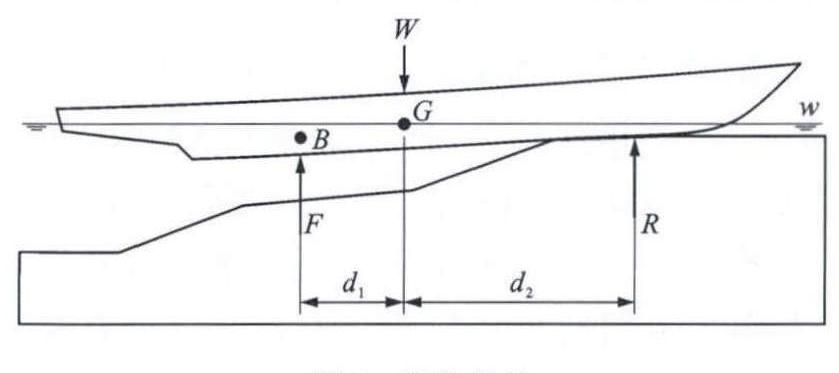Calculation method of grounding ship during righting process
Article Text (Baidu Translation)
-
摘要: 为了研究搁浅船舶的打捞, 计算了船舶扳正过程中搁坐力和纵倾角的变化, 分析了船舶舱室内的自由液面在搁浅船舶扳正过程中的作用。根据搁浅船舶的受力特点, 建立了其力学模型。针对传统搁坐力计算方式的缺点, 利用GHS软件模拟搁浅船舶的扳正过程, 并以某搁浅船舶为例, 求解该过程中各搁坐点的搁坐力、总搁坐力、横倾角和纵倾角。通过仿真模拟, 比较了船舶不同搁浅状态的扳正过程, 分析了搁坐点位置、吃水、船体型线和船舶重力分布对搁浅船舶受力和姿态的影响。分析结果表明: 搁坐点位置相对分散或船体吃水较深时, 船体的纵倾角变化相对较小, 变化量为其他类型的0.1%~2.0%;搁坐点关于船舯非对称产生的总搁坐力变化量相对搁坐点关于船舯对称产生的总搁坐力较小, 前者变化量为后者的35%~65%;舱室内自由液面的存在加大了搁浅船舶打捞的难度, 因此, 在制定打捞方案时应该着重考虑其影响; 施工过程中也应控制搁浅船舶翻转的速度, 避免阻碍扳正工作或对船舶产生进一步的破坏。Abstract: In order to study the salvage of grounding ship, the changes of grounding force and trim angle during righting process were computed.The function of free surface in cabins during righting process was analyzed.The force module of grounding ship was established based on the stress characteristics of grounding ship.Considering the shortcomings of traditional calculation method of grounding force, taking an grounding ship as an example, the grounding force of every grounding point, total grounding force, heel angle and trim angle were calculated during righting process simulated by GHS software.The righting processes of ship with different grounding states were compared through simulation, and the effects of the positions of grounding point, draft, shiplines and weight distribution on the force and attitude of grounding ship were analyzed.Analysis result indicates that for grounding ship with dispersion of grounding point or deep draft, the variation of trim angle is relatively smaller, and is 0.1%-2.0%of that of other situation.The variations of total grounding forces for grounding points which are dissymmetrical about midship are smaller than the variations that the points are symmetric about midship, and the variations of the formers are 35%-65%of the laters.The influence of free surface add more difficulties to wreck salvage, and so it should be emphatically considered in making salvage scheme.The overturn speed of wreck in the project should be controlled in order to avoid blocking of righting progress or further damage to ships.
-
Key words:
- wreck salvage /
- grounding ship /
- righting process /
- GHS software /
- hull strength /
- grounding force /
- trim angle
-
表 1 船舶主尺度
Table 1. Principal dimensions of ship

-
[1] WIESLAW G. The ships impact in ground of port water area[J]. R & amp; amp; RATA, 2008, 1(2): 61-66. [2] GALOR W. The model of ship movement while touching the sea-bed[J]. International Journal on Marine Navigation and Safety of Sea Transportation, 2007, 1(4): 413-418. [3] WOELKE P B. SHIELDS M D, ABBOUD N N, et al. Simulations of ductile fracture in an idealized ship grounding scenario using phenomenological damage and cohesive zone models[J]. Computational Materials Science, 2013, 80(1): 79-95. [4] HONG L, AMDAHL J. Ship grounding over rock and shoal[J]. International Journal of Offshore and Polar Engineering, 2011, 21(1): 61-69. [5] LIU Zhen-hui, AMDAHL J. Numerical and simplified analytical methods for analysis of the residual strength of ship double bottom[J]. Ocean Engineering. 2012, 52, 22-34. [6] 朱洪磊. 搁浅船舶脱浅拉力计算及应用[D]. 大连: 大连海事大学. 2013.ZHU Hong-lei. Calculating and application of refloating tension of stranding ship[D]. Dalian: Dalian Maritime University, 2013. (in Chinese). [7] 刘雨, 李艮田. 搁浅"达飞利波拉"轮抢险救助工程[C]∥中国航海学会救助打捞专业委员会. 第七届中国国际救捞论坛论文集. 北京: 海洋出版社, 201 2: 138-141. LIU Yu, LI Gen-tian. Emergence rescue of grounding ship"dafeilibola"[C]//The Rescue and Salvage Committee of China Institute of Navigation. Proceedings of the 7th China International Rescue and Salvage Conference. Beijing: China Ocean Press, 2012: 138-141. (in Chinese). [8] 高鸿. 航道边搁浅的大吨位船舶的快速救助[C]//中国航海学会救助打捞专业委员会. 第七届中国国际救捞论坛论文集. 北京; 海洋出版社, 2012: 142-144. GAO Hong. Fast salvage for aground large vessel beside channel[C]//The Rescue and Salvage Committee of China Institute of Navigation. Proceedings of the 7th China International Rescue and Salvage Conference. Beijing: China Ocean Press, 2012: 142-144. (in Chinese). [9] 娄睿, 王鹏, 周绪强. 大型搁浅船舶的救助[C]//中国航海学会救助打捞专业委员会. 第七届中国国际救捞论坛论文集. 北京: 海洋出版社, 2012: 152-154. LOU Rui, WANG Peng, ZHOU Xu-qiang. The brief explanation of the salvation about big tonnage cargo ship taking the ground[C]//The Rescue and Salvage Committee of China Institute of Navigation. Proceedings of the 7th China International Rescue and Salvage Conference. Beijing: China Ocean Press, 2012: 152-154. (in Chinese). [10] NGUYEN T H, GARRE L, AMDAHL J, et al. Monitoring of ship damage condition during stranding[J]. Marine Structures, 2011, 24(3): 261-274. doi: 10.1016/j.marstruc.2011.02.006 [11] PEDERSEN P T, ZHANG Sheng-ming. Effect of ship structure and size on grounding and collision damage distributions[J]. Ocean Engineering, 2000, 27: 1161-1179. doi: 10.1016/S0029-8018(99)00043-8 [12] ALSOS H S, AMDAHL J. On the resistance of tanker bottom structures during stranding[J]. Marine Structures, 2007, 20(4): 218-237. doi: 10.1016/j.marstruc.2007.06.001 [13] ZHANG Sheng-ming. Plate tearing and bottom damage in ship grounding[J]. Marine Structures, 2002, 15(2): 101-117. doi: 10.1016/S0951-8339(01)00021-1 [14] NGUYEN T H, AMDAHL J, LEIRA BJ, et al. Understanding ship-grounding events[J]. Marine Structures, 2011, 24(4): 551-569. doi: 10.1016/j.marstruc.2011.07.001 [15] WANG G E, ARITA K, LIU D. Behavior of a double hull in a variety of stranding or collision scenarios[J]. Marine Structures, 2000, 13(3): 147-187. doi: 10.1016/S0951-8339(00)00036-8 [16] ABDEL-GAWAD A F, RAGAB S A, NAYFEH A H, et al. Roll stabilization by anti-roll passive tanks[J]. Ocean Engineering, 2001, 28: 457-469. doi: 10.1016/S0029-8018(00)00015-9 [17] WANG Hai-yan, REN Jun, WANG Jin, et al. Developing a conceptual framework to evaluate effectiveness of emergency response system for oil spill[J]. Journal of Traffic and Transportation Engineering: English Edition, 2014, 1(2): 120-128. doi: 10.1016/S2095-7564(15)30096-9 [18] KIM Y. Experimental and numerical analyses of sloshing flows[J]. Journal of Engineering Mathematics, 2007, 58(1): 191-210. [19] 卫志军, 岳前进, 阮诗伦, 等. 矩形液舱晃荡冲击载荷的试验机理研究[J]. 船舶力学, 2012, 16(8): 885-892. doi: 10.3969/j.issn.1007-7294.2012.08.007WEI Zhi-jun, YUE Qian-jin, RUAN Shi-lun, et al. An experimental investigation of liquid sloshing impact load on a rectangular tank[J]. Journal of Ship Mechanics, 2012, 16(8): 885-892. (in Chinese). doi: 10.3969/j.issn.1007-7294.2012.08.007 [20] GAO Qiu-xin, VASSALOS D. Numerical study of damage ship hydrodynamics[J]. Ocean Engineering, 2012, 55: 199-205. doi: 10.1016/j.oceaneng.2012.08.003 [21] WANG Ge, SPENCER J, CHEN Yong-jun. Assessment of a ship's performance in accidents[J]. Marine Structures, 2002, 15(4/5): 313-333. [22] PAIK J K. Practical techniques for finite element modeling to simulate structural crashworthiness in ship collisions and grounding(part Ⅰ: theory)[J]. Ships and Offshore Structures, 2007, 2(1): 69-80. doi: 10.1533/saos.2006.0148 [23] AMDAHL J, KAVLIE D, JOHANSEN A. Tanker Grounding Resistance[C]//Elsevier. Proceedings of the Sixth International Symposium on Practical Design of Ships and Mobile Units. Seoul: Elsevier, 1995: 1072-1083. [24] NGUYEN T H, GARRE L, AMDAHL J, et al. Benchmark study on the assessment of ship damage conditions during stranding[J]. Ships and Offshore Structures, 2012, 7(2): 197-213. doi: 10.1080/17445302.2010.537087 [25] SIMONSEN B C, WIERZBICKI T. Grounding bottom damage and ship motion over a rock[J]. International Journal of Offshore and Polar Engineering, 1996, 6(3): 195-202. [26] MCQUILLAN J. Modeling dynamic ground reaction to predict motion and loads on stranded ships in waves[D]. Blacksburg: Virginia Polytechnic Institute and State University, 2002. -





 下载:
下载:












